Making fillable forms in Excel is a breeze and it’s a game-changer for your data entry and collection game. First up, slap on some form field names and toss in content controls like buttons, check boxes, list boxes, and combo boxes onto your worksheet. Crank up the customization and functionality by tweaking those form settings with Format Control.
Filling out these forms is no sweat either. Punch in what’s needed, and then let Excel flex its data analysis muscles to make sense of your form results. These forms are a godsend for stuff like customer feedback, giving you a neat and tidy way to scoop up and make sense of what your customers are saying.
Understanding the basics of Excel forms
Excel forms are the MVPs when it comes to data entry, collection, and getting the lowdown from customers. They’re kitted out with fillable fields and nifty content controls like buttons, check boxes, list boxes, and combo boxes. Those form field names? They’re your secret weapon for keeping that data neat and tidy for some top-notch analysis.
You get to make that worksheet your own with form settings, while Format Control is like the magic wand for tweaking how those form controls look and work. And when it’s time to wrap up, form results are your trusty sidekick, summing up all that info you’ve gathered in a snap, making analysis a walk in the park.
What are Excel forms?
Excel Forms are the go-to for when you need to get down to business with data entry and collection. Picture this: you’re filling in info straight into an Excel worksheet, playing around with content controls like buttons, check boxes, list boxes, and combo boxes as you go.
And with Format Control in your corner, you’re analyzing data and customizing form field names and settings like a pro. Excel Forms are your ace in the hole for pulling in customer feedback or any other form results. Bottom line, these fillable forms are all about making your data gathering and analyzing smooth sailing.
Why use Excel forms?
Excel forms are your easy-peasy solution for collecting info or plugging data into a worksheet for some serious data analysis. They’re decked out with fillable forms and content controls—think buttons, check boxes, list boxes, and combo boxes—that make data entry a walk in the park. And those form field names? You can tailor them to whatever floats your boat.
This nifty feature doesn’t just make data collection a cinch; it’s also a powerhouse for managing customer feedback. Tweak those form settings, and you’re changing up how form results show up, making it a must-have for any biz or project that needs a slick method of data collection.
How to create custom forms in Bonsai
Creating custom forms in Bonsai involves leveraging their built-in customization options for proposals and contracts. Here’s a step-by-step guide to creating custom forms in Bonsai:
1. Log in to Bonsai
- Log in to your Bonsai account and navigate to the dashboard.
- Navigate to Proposals or Contracts: Depending on whether you want to create a form for a proposal or a contract, click on the corresponding tab in the dashboard.
- If you’re starting from scratch, click on "New Document" or "Create Proposal" / "Create Contract".
- If you have an existing document you want to modify, find it in your list of proposals/contracts and click on it to edit.
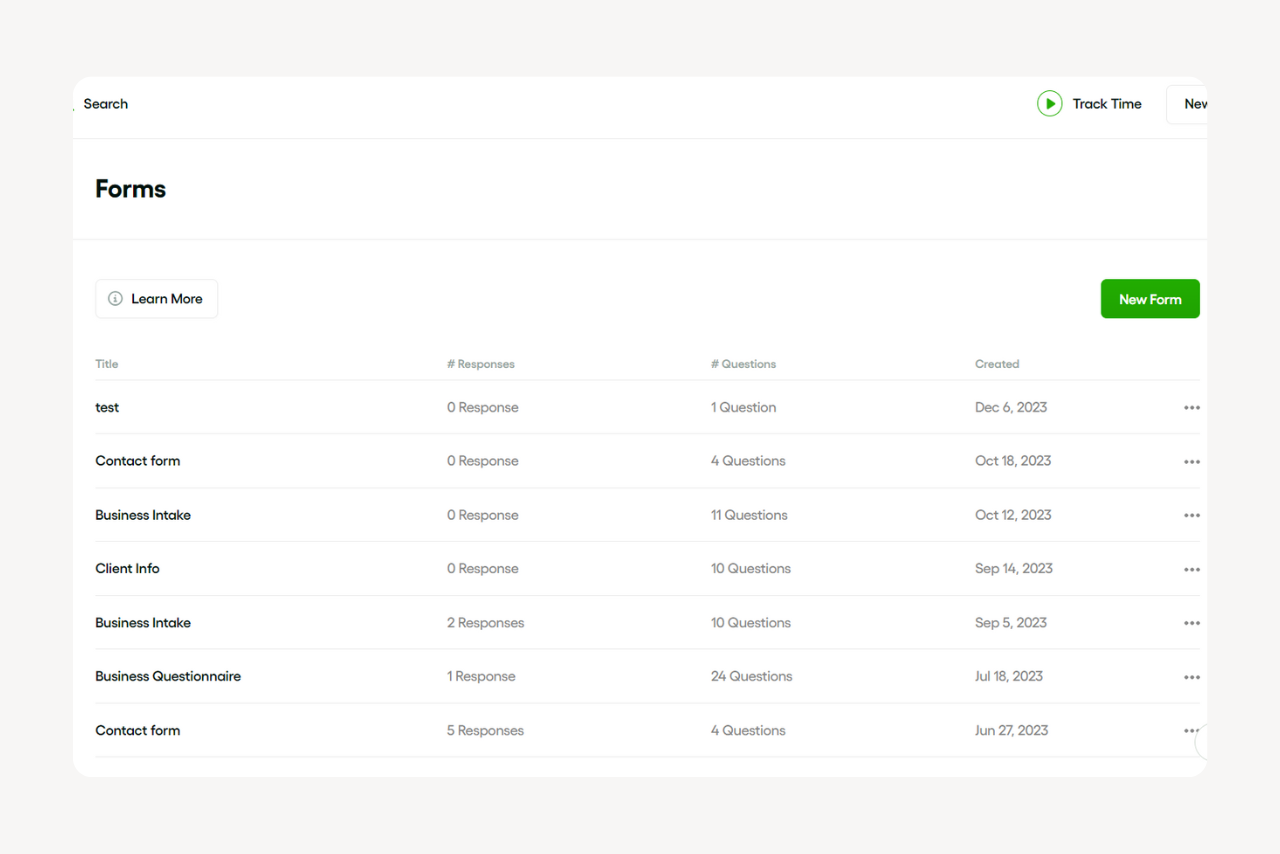
2. Edit the document
- Once you’re in the document editor, you can add sections, headings, text blocks, and other elements using the editing tools provided by Bonsai.
- Use the toolbar to format text, insert placeholders for client information or dynamic variables (like project names, dates, etc.), and customize the layout.
3. Add form fields
- Bonsai allows you to add custom fields to your documents. These can include text fields, checkboxes, dropdowns, and other types of input fields.
- To add a custom field, click on "Add Content" or a similar button depending on where you want to insert the field (e.g., before a section, within a section).
- After adding a field, you can customize its properties by clicking on it.

4. Preview and test
- Once you’ve added and customized your form fields, preview the document to ensure everything looks as expected.
- Test the form by filling it out as if you were the client. Make sure all fields function correctly and the document meets your needs.
5. Save and finalize
- After you’re satisfied with your custom form, save the document.
- If it’s a new document, you’ll be prompted to name it and save it as a proposal or contract.
- If you’re editing an existing document, simply save your changes.
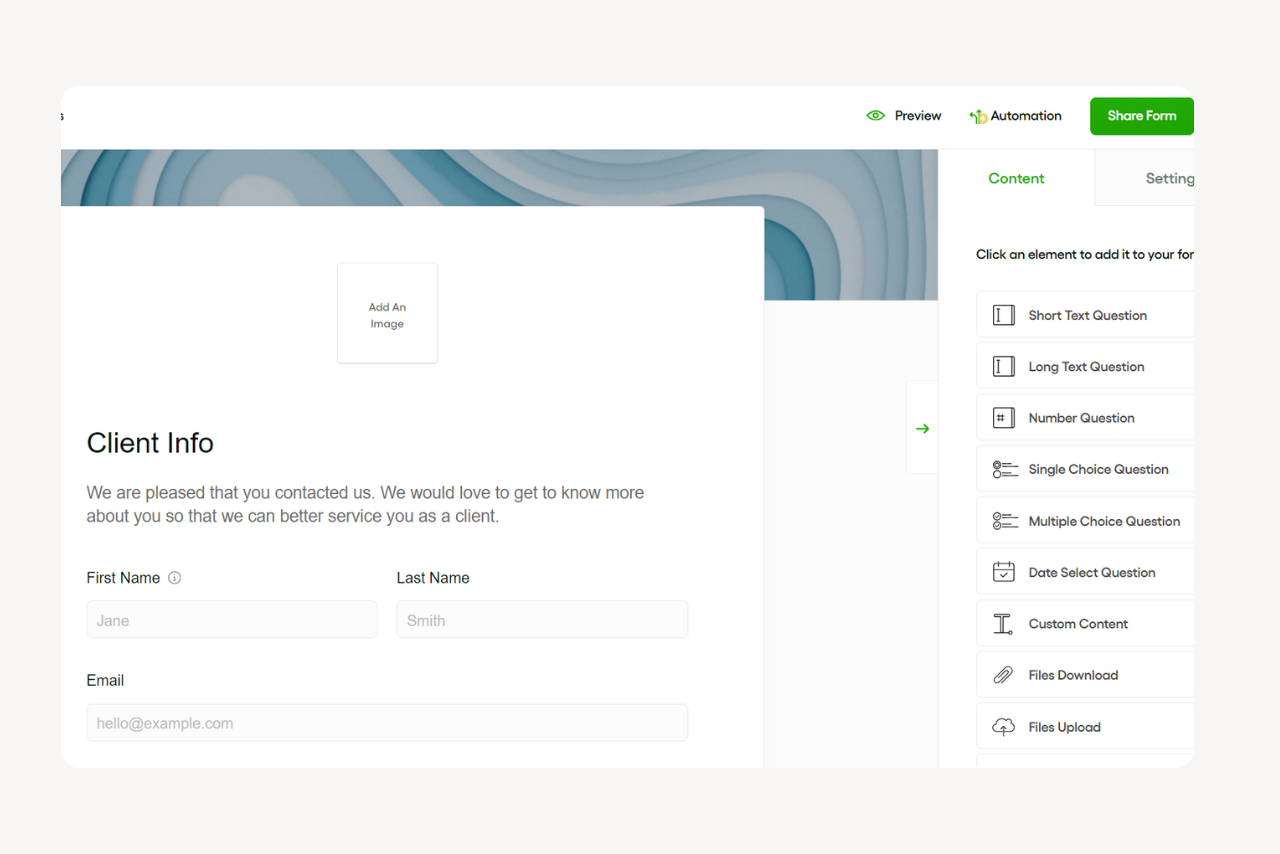
6. Send or use your custom form
- Use the custom form by sending it directly to clients via Bonsai’s sharing options.
- You can also use the form internally for record-keeping or as a template for future documents.
- Periodically review your custom forms to ensure they remain up-to-date and effective.
By following these steps, you can create tailored forms within Bonsai that streamline your proposal and contract processes, making them more efficient and professional.
Getting started with Excel forms
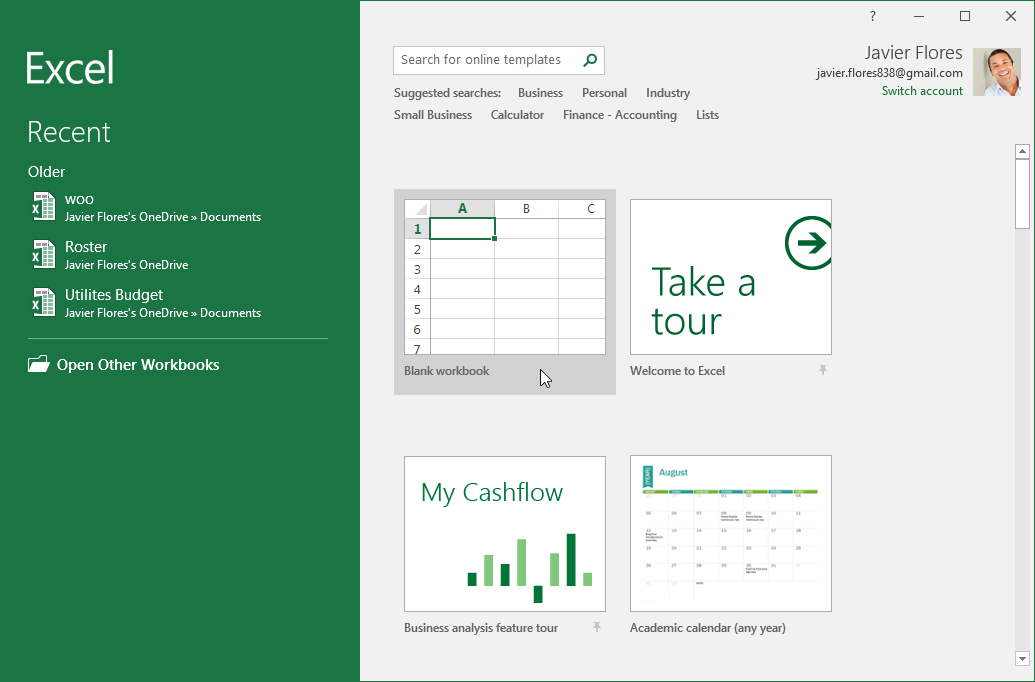
Excel forms are an excellent tool for data collection, enabling meticulous data entry and customer feedback acquisition. Filled with content controls such as buttons, check boxes, list boxes, and combo boxes, they facilitate easy interaction and data input. They also provide form field names for tagged data organization.
Moreover, form settings can be modified according to specific requirements. It's possible to create fillable forms within your worksheet, thereby fortifying data analysis capabilities. Last but not least, Format Control helps manage form results, providing an organized summary view of collected details.
Setting up your Excel environment
Setting up your Excel environment begins with establishing content controls such as buttons, check boxes, list boxes, and combo boxes. These tools are excellent for data entry and customer feedback collection, and they are inserted via the Format Control function on your worksheet.
Proper use of these tools allows for the creation of fillable forms with defined form field names, simplifying data collection and analysis.
Finally, integrate your form settings to customize the appearance and functionality of your form, thereby enhancing the usability of your form results.
Understanding Excel form controls
Excel Form Controls are interactive elements like content controls, buttons, and check boxes, which provide a systematic way for data entry, data collection, and data analysis. These controls, such as list boxes and combo boxes, can be inserted into a worksheet for making it more interactive for the user and acquiring customer feedback in an organized way.
Form Controls become more efficient when combined with form field names. You can use features like 'Format Control' to modify form settings and tailor fillable forms according to your needs. Thus, form controls simplify the process of gathering and examining form results.
Creating a simple Excel form
Creating a simple Excel form involves using features like content controls, buttons and checkboxes. Start by setting up your worksheet with the desired form field names. Then incorporate the likes of list boxes and combo boxes for more interactive, fillable forms that facilitate easier data entry.
You may then tweak your form settings as per the requirements of your data collection or customer feedback process. Lastly, remember to use the 'Format Control' feature to handle your form results for seamless data analysis.
Designing the form layout
When designing a form layout, certain aspects need to be considered for efficient data entry and collection. The form should incorporate content controls like buttons, check boxes, and combo boxes for clear interaction. Careful thought should be given to form field names to avoid confusion during data analysis.
Additionally, list boxes could be utilized to present multiple options and facilitate customer feedback collection. The overall worksheet ought to be user-friendly, facilitating easy navigation for those filling the forms. It's critical to integrate Format Control for a consistent layout and readability of form results.
Finally, form settings should be customized to suit business requirements and drive effective data collection. Special attention must be given to creating fillable forms that engage users and enhance their overall experience.
Adding form controls
Form controls are crucial in data collection and data analysis. They include various elements like content controls, buttons, check boxes, list boxes, combo boxes, and some form settings. These elements facilitate easy data entry and customer feedback collection.
Adding form controls is a simple procedure that involves naming the form field names, choosing the form control, then dragging it to your worksheet. By using Format Control, you can customize the look of your fillable forms to meet your specific needs.
The form results are essential in providing useful information about the audience's needs and preferences. Hence, form controls are highly valuable for any business that values customer feedback and efficient data analysis.
Configuring form controls
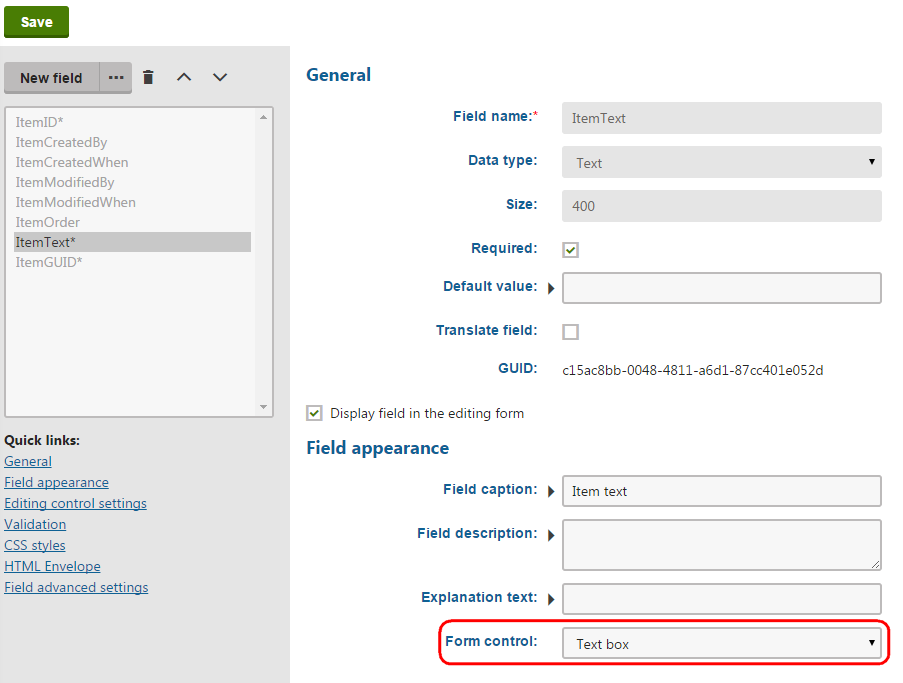
Form controls are essential for data collection, facilitating better data entry, and gathering customer feedback. These controls include content controls like buttons, check boxes, list boxes, and combo boxes. These elements help in creating fillable forms on a worksheet and improve data analysis.
Configuring these controls involves defining form field names and adjusting form settings to achieve the desired interaction and collect the necessary data. In essence, the Format Control feature is vital in this configuration process as it manages the presentation and form results.
Mastering the setup of form controls enhances the efficiency of data collection processes like customer feedback and data analysis. It eases data entry and collection, making for a user-friendly form experience.
Advanced Excel form techniques
Advanced Excel offers robust functionalities for form techniques which massively simplify data analysis. From easily customizable content controls and data entry enhancements like buttons, check boxes, list boxes, to combo boxes, Excel provides a great data collection interface for customer feedback, form results, and so much more.
Advanced features like Format Control can help adjust form field names and settings, allowing you to turn worksheets into fillable forms. This proficiency not only increases efficiency in data collection but also enhances the accuracy of your records. Understanding these Excel form techniques can substantially improve your productivity and data analysis abilities.
Using formulas in Excel forms
Using formulas in excel forms facilitates data analysis, enhances data entry, and aids in effective data collection. Excel allows you to apply formulas directly on the worksheet, enabling you to interpret form results more efficiently. Formatting control can help manage content controls such as buttons, check boxes, list boxes and combo boxes.
The customer feedback can be more organized and clear through the use of fillable forms, which would in turn improve form settings. Also, form field names can be set to capture specific information, providing a more structured and streamlined way of handling data.
Applying conditional formatting to Excel forms
Applying conditional formatting in Excel can be useful in enhancing data presentation and data analysis. It allows worksheet users to visually differentiate and analyze data sets based on specific criteria. Forms with content controls like buttons, check boxes, list boxes and combo boxes can effectively be used for data collection such as customer feedback and data entry.
With Format Control, you can alter form settings and update form field names for clearer data interpretation. Additionally, when creating fillable forms, conditional formatting is essential as it can aid in better visualization of form results thereby improving overall user experience.
Completing and using Excel forms
To efficiently use Excel forms for data collection, several elements like content controls, buttons, combo boxes, and worksheets are needed. The buttons provide interactive form field names for ease of data entry and therefore help to streamline the process of obtaining customer feedback. Content controls help with format control, allowing users to create fillable forms readily, improving productivity by a significant margin.
Moreover, other features like check boxes and list boxes further boost the functionality of Excel forms. Check boxes facilitate binary choices in your form settings, whereas list boxes offer selection from multiple options, thereby improving data analysis. Thus, Excel forms help organize crucial data collection efforts, manage form results, and foster smooth interactions with customers.
Filling out Excel forms

Filling out Excel forms consists of data entry into various fields, facilitated with the use of content controls such as buttons, check boxes, and combo boxes. These controls facilitate the collection and data analysis of the form results.
Moreover, list boxes and Format Control features in a worksheet, as part of form settings, help to organize and categorize the data. They improve the efficiency of data collection for tasks like customer feedback analysis.
It is important to set clear and precise form field names in fillable forms to ensure accurate data input and easy interpretation of the results gathered.
Extracting data from Excel forms
Data extraction from Excel forms plays a pivotal role in attaining data analysis and customer feedback. By using fillable forms, data collection becomes a seamless process. The forms can be manipulated using elements like list boxes, combo boxes, check boxes and buttons.
These features are accessible via Format Control. It is essential to appropriately set form settings to ensure accurate form results. Names of form fields must be well defined for seamless data entry purposes. Moreover, leveraging on content controls compounds the accuracy and efficiency of data collection.
Therefore, mastering the process of data extraction from Excel forms is immensely beneficial for businesses and enterprises.
Excel form limitations and solutions
Excel forms are a staple when you’re diving into data collection and analysis, especially for customer feedback and data entry. But let’s face it, they’ve got their quirks, like limited content controls and not enough pizzazz in the dynamic interaction department. This can throw a wrench in the works with buttons, check boxes, list boxes, and combo boxes, which are key players for nailing those form settings and snagging form results.
Here’s a pro tip to dodge these hurdles: whip out the Format Control feature to tweak the function of buttons and list boxes. Plus, getting your form field names spot on can make your data collection smoother than silk. And don’t forget, crafting fillable forms is like giving data entry a turbo boost, sharpening up accuracy and making data analysis a whole lot slicker.
Understanding Excel form limitations
Excel forms are pretty slick for data analysis and data entry, but they’ve got their limits. Keep it short and sweet—form field names should stay under 31 characters. And here’s a heads-up: Excel can handle only up to 32,500 content controls, including the whole gang of buttons, check boxes, list boxes, and combo boxes.
If you’re juggling big tasks like data collection or raking in customer feedback with forms, you might hit a wall since all that data might not fit snugly within the form settings. This could throw a spanner in the works when you’re trying to manage form results, as the worksheet might not show the full picture of the data you’ve collected.
Using Bonsai Forms as an alternative
Bonsai forms offers an innovative alternative to traditional contracts and proposals. It streamlines the process of creating, sending, and signing documents with its intuitive design and user-friendly interface. Bonsai Forms reduces the need for physical storage, cuts down on paper waste, and enhances efficiency. The platform's secure environment ensures that sensitive information is protected, while its electronic signature feature expedites approvals.
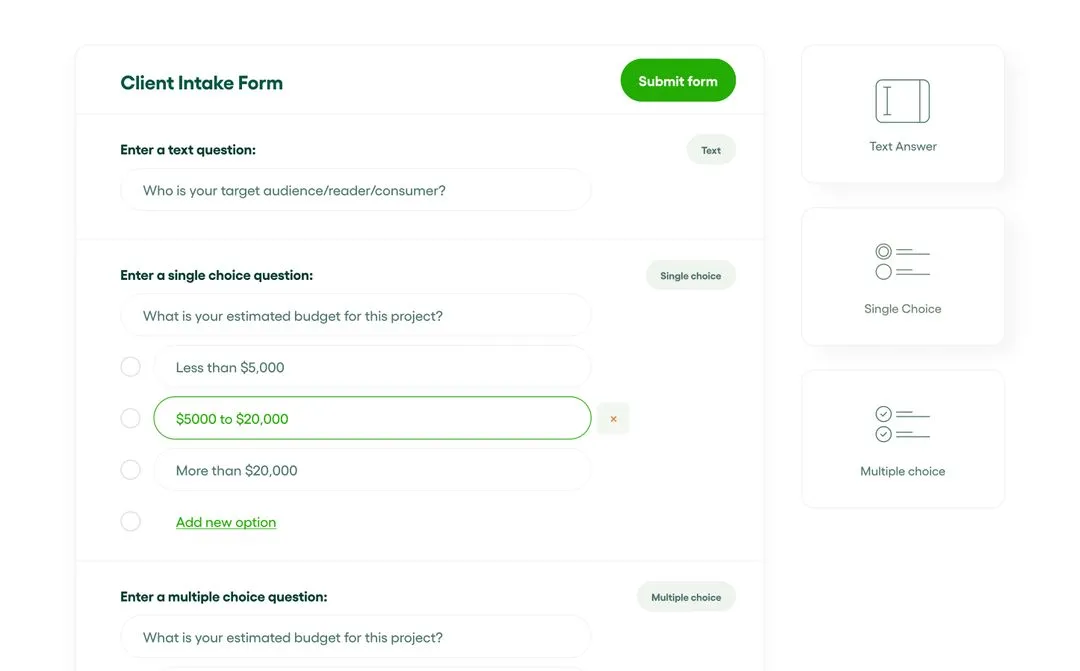
For professional service providers, and businesses, Bonsai Forms represents a sustainable, modern solution that simplifies administrative tasks, allowing more focus on core activities and fostering professional growth.
Using Microsoft Forms as an alternative
Microsoft Forms is like the Swiss Army knife for data collection and data analysis with fillable forms. It lets you whip up form field names and sprinkle in content controls such as buttons, check boxes, list boxes, and combo boxes for max user interaction. These controls are the secret sauce for structured data entry, which is a big deal when you’re collecting customer feedback.
The Format Control feature in Microsoft Forms is like having a remote control for your form settings, letting you dial in the specifics. Once you’ve gathered your data, you can ship those form results over to a worksheet for some extra crunching, making it a top-notch tool for business data processing.
Best practices for Excel forms
Crafting a top-tier Excel form takes some finesse, from the drawing board to the finish line. Key move? Roll out the content controls, including buttons, check boxes, list boxes, and combo boxes, to level up data entry and customer feedback collection. These bad boys let users get chummy with your form, while you call the shots on the type and format of info collected.
Line up those controls just right on the worksheet and use Format Control to make them look the part. Keep your form field names clear and to the point to dodge any head-scratching. And don’t skimp on using Excel’s form settings to gather and analyze data like a pro. In the end, it’s all about form results that make sense and fillable forms that make the whole experience a breeze for users.
Designing user-friendly Excel forms
When you’re designing user-friendly Excel forms, you’ve gotta keep your eye on a few key things. Toss in content controls like buttons, check boxes, list boxes, and combo boxes to make your form pop and feel intuitive. Naming your form field names with care is a big help for data analysis down the line.
With Format Control settings at your fingertips, you can fine-tune how those fillable forms work their magic. The endgame? Making data entry so smooth for the user, they’ll hardly notice they’re doing it. Dialing in those form settings not only boosts data collection but also gets a thumbs up for customer feedback by making sure form results are easy to get to and understand.
Maintaining and updating Excel forms
Keeping your Excel forms in tip-top shape is key for data collection and data entry that hits the mark. This means giving the content controls, including buttons, check boxes, list boxes, and combo boxes, a once-over now and then. It’s crucial to revisit and tweak form settings as needed to keep those form results accurate and user-friendly.
Format Control is your wingman in the maintenance game, helping you keep data analysis neat and tidy with an organized view of customer feedback. Plus, having form field names that are standardized and using fillable forms can make gathering and interpreting info a whole lot smoother.
Remember, keeping your worksheet fresh and up-to-date is a game-changer for data accuracy and the success of your project.
Bonsai is a comprehensive project management platform designed to streamline the workflow of freelancers and small businesses. With a focus on simplicity and efficiency, Bonsai offers a suite of tools that cover the entire project lifecycle, from proposal to payment. It's an all-in-one solution that combines project planning, time tracking, invoicing, and client management, all within a user-friendly interface.
Conclusion
Wrapping things up, buttons, check boxes, and list boxes are the unsung heroes in fillable forms, making data entry a walk in the park and giving data analysis a leg up. Combo boxes in a worksheet are like the secret ingredient for form settings that hit the nail on the head, leading to spot-on form results. And Format Control? It’s the wizard behind customizing form field names, leveling up data collection and customer feedback.






